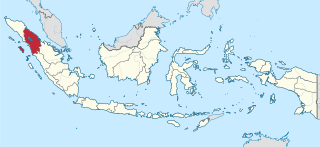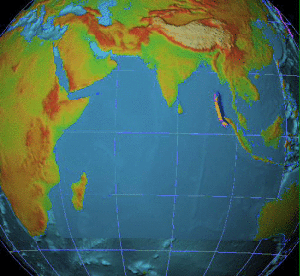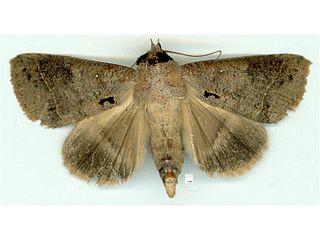
Sumatra is one of the Sunda Islands of western Indonesia. It is the largest island that is fully within Indonesian territory, as well as the sixth-largest island in the world at 475,807.63 km2 (182,812 mi.2), including adjacent islands such as the Simeulue, Nias, Mentawai, Enggano, Riau Islands, Bangka Belitung and Krakatoa archipelago.

North Sumatra is a province of Indonesia located in the northern part of the island of Sumatra. Its capital and largest city is Medan. It is bordered by Aceh on the northwest and Riau and West Sumatra on the southeast, with two different coastlines located on the Indian Ocean and the Strait of Malacca, and a maritime border with Malaysia to the east. North Sumatra is Indonesia's fourth most populous province after West Java, East Java, and Central Java, and is also the most populous province outside of Java Island. North Sumatra is also the third-largest province in area on the island of Sumatra after South Sumatra and Riau provinces. It covers an area of 72,460.74 km2, which is approximately the same size as Sierra Leone or Scotland or Maine.

Nias is an island located off the western coast of Sumatra, Indonesia. Nias is also the name of the archipelago of which the island is the centre, but also includes the Batu Islands to the southeast and the small Hinako Islands to the west. Nias Island covers an area of 5,573.27 km2 (2,151.85 sq mi). It is mostly a lowland area rising to around 800 m (2,600 ft) above sea level. There were 756,338 inhabitants on the island at the 2010 Census; at the 2015 Intermediate Census this had risen to 798,506 and the 2020 Census resulted in a total of 880,550. The official estimate as of mid-2023 was 930,294.

Sibolga is a city and a port located in the natural harbour of Sibolga Bay on the west coast of North Sumatra province, in Indonesia.

Indonesia was the first country to be seriously affected by the earthquake and tsunami created by the 2004 Indian Ocean earthquake on 26 December 2004, swamping the northern and western coastal areas of Sumatra, and the smaller outlying islands off Sumatra. Nearly all the casualties and damage took place within the province of Aceh. The time of arrival of the tsunami was between 15 and 30 minutes after the deadly earthquake. According to the country's National Disaster Relief Coordination Agency, around 130,000 people were dead and 37,063 were missing. In addition, the UN estimated that 655,000 people were homeless and sheltering in scattered refugee camps across the province.

The 2005 Nias–Simeulue earthquake occurred on 28 March off the west coast of northern Sumatra, Indonesia. At least 915 people were killed, mostly on the island of Nias. The event caused panic in the region, which had already been devastated by the massive tsunami triggered by the 2004 Indian Ocean earthquake, but this earthquake generated a relatively small tsunami that caused limited damage. It was the third most powerful earthquake since 1965 in Indonesia.

Gunungsitoli is a city located in North Sumatra province, Indonesia, on the Indian Ocean island of Nias, west of Sumatra. Gunungsitoli is the island's only city and is the main hub for the island and surrounding smaller islands. Located on the north-eastern side of Nias island, the city was historically a series of fortifications made by the Dutch colonial administration in the 1600s to defend against frequent raids from Nias tribes, especially those from southern parts of the island. Until 1914, it was the only part of the island that was effectively controlled by the Dutch.

Danaus genutia, the common tiger, is one of the common butterflies of India. It belongs to the "crows and tigers", that is, the Danainae group of the brush-footed butterflies family. The butterfly is also called striped tiger in India to differentiate it from the equally common plain tiger, Danaus chrysippus. The species was first described by Pieter Cramer in 1779.

Danaus melanippus, the black veined tiger, white tiger, common tiger, or eastern common tiger, is a butterfly species found in tropical Asia which belongs to the "crows and tigers", that is, the danaine group of the brush-footed butterflies family.

Operation Sumatra Assist was the Australian Defence Force's (ADFs) contribution to disaster relief in Indonesia following the 2004 Indian Ocean earthquake. ADF personnel were deployed within hours of the earthquake. They served mainly in Aceh. Medical and engineering staff were prominent, with helicopters and cargo aircraft, supported offshore by HMAS Kanimbla and its two Sea King helicopters.

Hasora, the awls, are a genus of skipper butterflies. Hasora species are found in the Indomalayan and Australasian realms.

North Nias Regency is located on Nias Island in the North Sumatra province of Indonesia. The regency was created on 29 October 2008 by dividing several districts that had been part of Nias Regency. It occupies the northern portion of Nias Island and has an area of 1,242.14 square kilometres (479.6 sq mi). At the 2010 census, it had a population of 127,244, and 147,274 at the 2020 census; the official estimate at mid 2023 was 155,873. The regency's administrative capital is Lotu.
The Northwest Sumatra–Barrier Islands languages are a group of Malayo-Polynesian languages spoken by the Batak and related peoples in the interior of North Sumatra and by the Nias, Mentawai people, and others on the Barrier islands off the western coast of Sumatra, Indonesia.

Trigonodes is a genus of moths erected by Achille Guenée in 1852. The genus was in the family Noctuidae, but is now mostly classified in the family Erebidae, along with all of the former members of the families Arctiidae and Lymantriidae. This re-classification has not yet met with general consensus, and many resources and publications still follow the older classification scheme.

Dysphania is a genus of colourful moths in the family Geometridae and typical of the tribe Dysphaniini; they are sometimes called 'false tiger moths' and are found in northeast Australia, Melanesia, and south, east and southeast Asia.

Ercheia cyllaria is a species of moth of the family Erebidae first described by Pieter Cramer in 1779. It is found in the Indian subregion, Sri Lanka, Taiwan, Japan, Indochina, Thailand, Peninsular Malaysia, Sumatra, Borneo, Seram and the Kai Islands.

Trigonodes hyppasia, the triangles or semi-looper, is a moth in the family Erebidae. The species was first described by Pieter Cramer in 1779. It is largely cosmopolitan, found throughout Borneo, Fiji, India, Maldives, Nepal, Sri Lanka, São Tomé and Príncipe, Taiwan, Thailand, Zimbabwe, northern Australia, and almost all African countries.

Pantydia metaspila is a species of moth of the family Erebidae first described by Francis Walker in 1858. It is found in China, Japan (Ryukyus), India (Maharashtra), Thailand, Taiwan, the Maledives, Sri Lanka, the Philippines, Borneo, Sumatra, Sulawesi, the Tanimbar Islands, Seram, Papua New Guinea, the Caroline Islands, the Solomon Islands, Vanuatu, Fiji, as well as Australia, where it has been recorded from Queensland.
The 1843 Nias earthquake off the northern coast of Sumatra, Indonesia caused severe damage when it triggered a tsunami along the coastline. The earthquake with a moment magnitude (Mw ) of 7.8 lasted nine minutes, collapsing many homes in Sumatra and Nias. It was assigned a maximum modified Mercalli intensity of XI (Extreme).
















